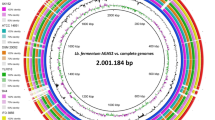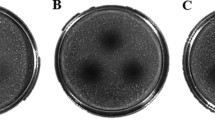Abstract
In this study, Streptococcus thermophilus and Lactobacillus bulgaricus strains from traditional Turkish yoghurts were isolated, identified by 16S rRNA sequencing and genotypically 14 S. thermophilus and 6 L. bulgaricus strains were obtained as distinct strains by MLST analysis. Lactic acid production levels of the L. bulgaricus strains were higher than S. thermophilus strains. HPLC analysis showed that EPS monosaccharide composition of the strains mainly consisted of glucose and galactose. In general, all strains were found to be susceptible for antibiotics, except some strains were resistance to gentamicin and kanamycin. Apart from two strains of S. thermophilus, all strains displayed strong auto-aggregation level greater than 95% at 24 h incubation. S. thermophilus strains showed higher cell surface hydrophobicity than L. bulgaricus strains. This study demonstrated the isolation, identification, genotypic discrimination and techno-functional features of wild type yoghurt starter cultures which can potentially find place in industrial applications.



Similar content being viewed by others
Data availability
The data that assist the results of this work provides from the corresponding writer upon acceptable demand.
References
Akpinar A, Yerlikaya O, Kiliccedil S. Antimicrobial activity and antibiotic resistance of Lactobacillus delbrueckii ssp. bulgaricus and Streptococcus thermophilus strains isolated from Turkish homemade yoghurts. African Journal of Microbiology Research. 5: 675–682 (2011)
Amorim JC, Piccoli RH, Duarte WF. Probiotic potential of yeasts isolated from pineapple and their use in the elaboration of potentially functional fermented beverages. Food Research International. 107: 518-527 (2018)
Aslim B, Onal D, Beyatli Y. Factors influencing autoaggregation and aggregation of Lactobacillus delbrueckii subsp. bulgaricus isolated from handmade yogurt. Journal of Food Protection. 70: 223–227 (2007)
Bao Q, Song Y, Xu H, Yu J, Zhang W, Menghe B, Zhang H, Sun Z. Multilocus sequence typing of Lactobacillus casei isolates from naturally fermented foods in China and Mongolia. Journal of Dairy Science. 99: 5202-5213 (2016)
Behringer M, Miller WG, Oyarzabal OA. Typing of Campylobacter jejuni and Campylobacter coli isolated from live broilers and retail broiler meat by flaA-RFLP, MLST, PFGE and REP-PCR. Journal of Microbiological Methods. 84: 194-201 (2011)
Boonsilp S, Thaipadungpanit J, Amornchai P, Wuthiekanun V, Bailey MS, Holden MT, Zhang C, Jiang X, Koizumi N, Taylor K. A single multilocus sequence typing (MLST) scheme for seven pathogenic Leptospira species. PLoS Neglected Tropical Diseases. 7: e1954 (2013)
Cebeci A, Gürakan GC. Comparative typing of L. delbrueckii subsp. bulgaricus strains using multilocus sequence typing and RAPD–PCR. European Food Research and Technology. 233: 377–385 (2011)
De Las Rivas B, Marcobal A, Munoz R. Allelic diversity and population structure in Oenococcus oeni as determined from sequence analysis of housekeeping genes. Applied and Environmental Microbiology. 70: 7210-7219 (2004)
Delorme C, Legravet N, Jamet E, Hoarau C, Alexandre B, El-Sharoud WM, Darwish MS, Renault P. Study of Streptococcus thermophilus population on a world-wide and historical collection by a new MLST scheme. International Journal of Food Microbiology. 242: 70-81 (2017)
Feng J, Jiang Y, Li M, Zhao S, Zhang Y, Li X, Wang H, Lin G, Wang H, Li T. Diversity and evolution of Lactobacillus casei group isolated from fermented dairy products in Tibet. Archives of Microbiology. 200: 1111-1121 (2018)
Flint S, Brooks J, Bremer P. The influence of cell surface properties of thermophilic streptococci on attachment to stainlesssteel. Journal of Applied Microbiology. 83: 508-517 (1997)
Gezginc Y, Topcal F, Comertpay S, Akyol I. Quantitative analysis of the lactic acid and acetaldehyde produced by Streptococcus thermophilus and Lactobacillus bulgaricus strains isolated from traditional Turkish yogurts using HPLC. Journal of Dairy Science. 98: 1426–1434 v
Gil-Rodríguez AM, Carrascosa AV, Requena T. Yeasts in foods and beverages: In vitro characterisation of probiotic traits. LWT-Food Science and Technology. 64: 1156-1162 (2015)
Giraffa G, Paris A, Valcavi L, Gatti M, Neviani E. Genotypic and phenotypic heterogeneity of Streptococcus thermophilus strains isolated from dairy products. Journal of Applied Microbiology. 91: 937-943 (2001)
Gut AM, Vasiljevic T, Yeager T, Donkor ON. Characterization of yeasts isolated from traditional kefir grains for potential probiotic properties. Journal of Functional Foods. 58: 56-66 (2019)
İspirli H, Demirbaş F, Dertli E. Characterization of functional properties of Enterococcus spp. isolated from Turkish white cheese. LWT-Food Science and Technology. 75: 358–365 (2017)
İspirli H, Dertli E. Isolation and identification of exopolysaccharide producer lactic acid bacteria from Turkish yogurt. Journal of Food Processing and Preservation. 42: e13351 (2018)
Ivanov I, Petrov K, Lozanov V, Hristov I, Wu Z, Liu Z, Petrova P. Bioactive Compounds Produced by the Accompanying Microflora in Bulgarian Yoghurt. Processes. 9: 114 (2021)
Ivanova P, Peykov S, Dimitrova A, Dimov S. Molecular typing by genus-specific PCR and RAPD profiling of diverse Lactobacillus delbrueckii strains isolated from cow, sheep and buffalo yoghurts. Biotechnology & Biotechnological Equipment. 22: 748-753 (2008)
Iyer R, Tomar S, Kapila S, Mani J, Singh R. Probiotic properties of folate producing Streptococcus thermophilus strains. Food Research International. 43: 103-110 (2010)
Kaushik JK, Kumar A, Duary RK, Mohanty AK, Grover S, Batish VK. Functional and probiotic attributes of an indigenous isolate of Lactobacillus plantarum. PloS One. 4: e8099 (2009)
Liu W, Yu J, Sun Z, Song Y, Wang X, Wang H, Wuren T, Zha M, Menghe B, Heping Z. Relationships between functional genes in Lactobacillus delbrueckii ssp. bulgaricus isolates and phenotypic characteristics associated with fermentation time and flavor production in yogurt elucidated using multilocus sequence typing. Journal of Dairy Science. 99: 89-103 (2016)
Lourens-Hattingh A, Viljoen BC. Yogurt as probiotic carrier food. International Dairy Journal. 11: 1-17 (2001)
Lu W, Kong W, Yang P, Kong J. A one-step PCR-based method for specific identification of 10 common lactic acid bacteria and Bifidobacterium in fermented milk. International Dairy Journal. 41: 7-12 (2015)
Maiden MC, Bygraves JA, Feil E, Morelli G, Russell JE, Urwin R, Zhang Q, Zhou J, Zurth K, Caugant DA. Multilocus sequence typing: a portable approach to the identification of clones within populations of pathogenic microorganisms. Proceedings of the National Academy of Sciences. 95: 3140-3145 (1998)
Miyoshi-Akiyama T, Hayakawa K, Ohmagari N, Shimojima M, Kirikae T. Multilocus sequence typing (MLST) for characterization of Enterobacter cloacae. PloS One. 8: e66358 (2013)
Pachekrepapol U, Lucey J, Gong Y, Naran R, Azadi P. Characterization of the chemical structures and physical properties of exopolysaccharides produced by various Streptococcus thermophilus strains. Journal of Dairy Science. 100: 3424-3435 (2017)
Ruas-Madiedo P, Hugenholtz J, Zoon P. An overview of the functionality of exopolysaccharides produced by lactic acid bacteria. International Dairy Journal. 12: 163-171 (2002)
Schiraldi C, Valli V, Molinaro A, Cartenì M, De Rosa M. Exopolysaccharides production in Lactobacillus bulgaricus and Lactobacillus casei exploiting microfiltration. Journal of Industrial Microbiology and Biotechnology. 33: 384-390 (2006)
Sert D, Mercan E, Dertli E. Characterization of lactic acid bacteria from yogurt-like product fermented with pine cone and determination of their role on physicochemical, textural and microbiological properties of product. LWT-Food Science and Technology. 78: 70-76 (2017)
Sharma A, Kaur J, Lee S, Park Y-S. Molecular discrimination of Lactobacillus brevis strains isolated from food products in South Korea using multilocus sequence typing. LWT-Food Science and Technology. 86: 337-343 (2017)
Sharma A, Kaur J, Lee S, Park Y-S. Genetic diversity analysis of Leuconostoc mesenteroides from Korean vegetables and food products by multilocus sequence typing. Applied Microbiology and Biotechnology. 102: 4853-4861 (2018)
Sharma A, Lee S, Park Y-S. Molecular typing tools for identifying and characterizing lactic acid bacteria: a review. Food Science and Biotechnology. 29: 1301-1318 (2020)
Song Y, Sun Z, Guo C, Wu Y, Liu W, Yu J, . . . Zhang, H. Genetic diversity and population structure of Lactobacillus delbrueckii subspecies bulgaricus isolated from naturally fermented dairy foods. Scientific Report. 6(1): 1-8 (2016)
Szutowska J, Gwiazdowska D. Probiotic potential of lactic acid bacteria obtained from fermented curly kale juice. Archives of Microbiology. 203: 975-988 (2021)
Urwin R, Maiden MC. Multi-locus sequence typing: a tool for global epidemiology. Trends in microbiology. 11:479-87 (2003)
Vinderola CG, Reinheimer JA. Lactic acid starter and probiotic bacteria: a comparative “in vitro” study of probiotic characteristics and biological barrier resistance. Food Research International. 36: 895-904 (2003)
Xu H, Liu W, Zhang W, Yu J, Song Y, Menhe B, Zhang H, Sun Z. Use of multilocus sequence typing to infer genetic diversity and population structure of Lactobacillus plantarum isolates from different sources. BMC Microbiology. 15: 1-10 (2015)
Xu Z, Guo Q, Zhang H, Wu Y, Hang X, Ai L. Exopolysaccharide produced by Streptococcus thermophiles S-3: molecular, partial structural and rheological properties. Carbohydrate Polymers. 194: 132-138 (2018)
Yerlikaya O, Saygili D, Akpinar A. Evaluation of antimicrobial activity and antibiotic susceptibility profiles of Lactobacillus delbrueckii subsp. bulgaricus and Streptococcus thermophilus strains isolated from commercial yoghurt starter cultures. Food Science and Technology. 41: 418-425 (2020)
Yilmaz MT, İspirli H, Taylan O, Bilgrami AL, Dertli E. Structural and bioactive characteristics of a dextran produced by Lactobacillus kunkeei AK1. International Journal of Biological Macromolecules. 200: 293-302 (2022a)
Yilmaz MT, İspirli H, Taylan O, Taşdemir V, Sagdic O, Dertli E. Characterisation and functional roles of a highly branched dextran produced by a bee pollen isolate Leuconostoc mesenteroides BI-20. Food Bioscience. 45: 101330 (2022b)
Yu J, Sun Z, Liu W, Xi X, Song Y, Xu H, Lv Q, Bao Q, Menghe B, Sun T. Multilocus sequence typing of Streptococcus thermophilus from naturally fermented dairy foods in China and Mongolia. BMC Microbiology. 15: 1-13 (2015)
Acknowledgements
This study was financially supported by TUBİTAK (Turkey) with the grand number 116G024. Hilal Dikmen was supported by TUBİTAK.
Author information
Authors and Affiliations
Contributions
HD: writing-original draft. HG: supervision. FD: methodology. SK: Investigation. HI: methodology. MA: project administration, MT: project administration, OS: project administration. ED: supervision.
Corresponding author
Ethics declarations
Conflict of interest
The writers inform no conflict of interest.
Additional information
Publisher's Note
Springer Nature remains neutral with regard to jurisdictional claims in published maps and institutional affiliations.
Supplementary Information
Below is the link to the electronic supplementary material.
Rights and permissions
Springer Nature or its licensor (e.g. a society or other partner) holds exclusive rights to this article under a publishing agreement with the author(s) or other rightsholder(s); author self-archiving of the accepted manuscript version of this article is solely governed by the terms of such publishing agreement and applicable law.
About this article
Cite this article
Dikmen, H., Goktas, H., Demirbas, F. et al. Multilocus sequence typing of L. bulgaricus and S. thermophilus strains from Turkish traditional yoghurts and characterisation of their techno-functional roles. Food Sci Biotechnol 33, 625–635 (2024). https://doi.org/10.1007/s10068-023-01366-2
Received:
Revised:
Accepted:
Published:
Issue Date:
DOI: https://doi.org/10.1007/s10068-023-01366-2




